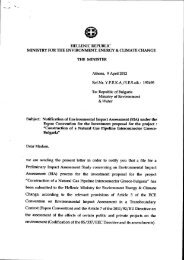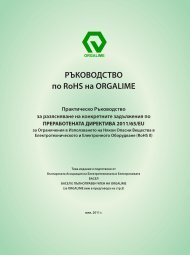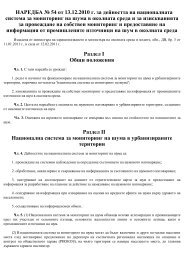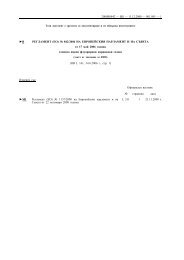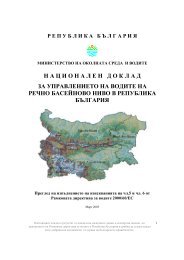Програма на научната конференция - Министерство на ...
Програма на научната конференция - Министерство на ...
Програма на научната конференция - Министерство на ...
- No tags were found...
You also want an ePaper? Increase the reach of your titles
YUMPU automatically turns print PDFs into web optimized ePapers that Google loves.
CLEISTOGAMY IN LAMIUM AMPLEXICAULE (LAMIACEAE)Tz. DaskalovaInstitute of Botany, Bulgarian Academy of Sciences, Acad. G. Bonchev Street,Block 23, 1113 Sofia, Bulgaria; E-mail: zvetana_daskalova@yahoo.deL. amplexicaule is winter annual plant, strongly calciphilous, widely distributed ongrassy and ruderal places in lowlands and foothills up to 1000 m altitude. It formstwo floral types – cleistogamous and chasmogamous and belongs to the specieswith “true cleistogamy”. A comparative study on the florogenesis usingbiometrical and embryological methods was carried out. An onthogenetic shift inbreeding system from cleistogamy (autogamy) to chasmogamy (xenogamy) wasindicated by increasing the size of the reproductive organs and possibility for anexpansion of the corolla during the anthesis. Cleistogamous flowers produced atthe first reproductive node had small anther sacs, narrow corolla and low pollencounts. Upper-node closed flowers had high pollen counts, large anther sacs, andwide corolla, like the chasmogamous ones, but failed to achieve an anthesis. Thenumber of pollen grains increases from the lower to the upper flower nodestogether with the anther sacs size and corolla width that is in correlation withanthesis. Histologically, the divergence in development between the 4 -thcleistogamous and 7 -th chasmogamous node occurred after the formation ofmicrospore mother cells in the anthers. A comparison of the approximate times tomeiosis, fertilization and seed set in the two floral types suggests that thecleistogamous flowers of 4 -th node were precocious in their development. Theresults obtained point to the possibility of existence of one more way in a largesystem of reproduction in Lamium amplexicaule in each of the individuals.13СИРФИДНИ МУХИ (SYRPHIDAE, DIPTERA) В ОСНОВНИ ВИДОВЕАГРОЕКОСИСТЕМИ НА СЛИВЕНСКАТА КОТЛОВИНАЕ. МарковаСофийски университет „Св. Климент Охридски”, Биологически факултет,Катедра Екология и опазване <strong>на</strong> природ<strong>на</strong>та среда, бул. Драган Цанков 8,1164-София; Е-mail: markovae@abv.bgНастоящото изследване е първото, при което се прави фаунистичен иекологичен а<strong>на</strong>лиз <strong>на</strong> сирфидните съобщества в някои основни видовеагроекосистеми <strong>на</strong> Сливенската котлови<strong>на</strong>. Изследвани са общо 14агроекосистеми – седем люцернови и седем пшенични от 7 пункта вкотлови<strong>на</strong>та. Материалът от сирфидни мухи е събран чрез метода <strong>на</strong>„косене” с помощта <strong>на</strong> ентомологичен сак със стандартни размери.Установени са основни популационни и ценотични параметри <strong>на</strong> сирфиднитесъобщества – видов състав, срещаемост <strong>на</strong> отделните видове, плътност <strong>на</strong>популациите, обща сред<strong>на</strong> плътност, доми<strong>на</strong>нт<strong>на</strong> и екологич<strong>на</strong> структура.101







